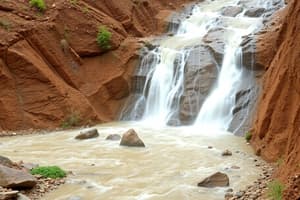Podcast
Questions and Answers
Which factor significantly contributes to the occurrence of rainfall-induced landslides?
Which factor significantly contributes to the occurrence of rainfall-induced landslides?
- Weakening of the slope materials (correct)
- Presence of vegetation
- Increased seismic activity
- High temperatures
What role do satellites play in managing geological hazards such as landslides?
What role do satellites play in managing geological hazards such as landslides?
- They prevent geological failures from occurring
- They assist in manually collecting soil samples
- They predict future earthquakes
- They help evaluate landslide occurrences in vulnerable areas (correct)
Which of the following environmental conditions can magnify the risk of landslides?
Which of the following environmental conditions can magnify the risk of landslides?
- Flat terrain with abundant vegetation
- Steep slopes with overloaded landfills (correct)
- Arid regions with no water presence
- Cold climates with minimal rainfall
What is the primary cause of landslides in areas with steep slopes during heavy rainfall?
What is the primary cause of landslides in areas with steep slopes during heavy rainfall?
Which type of geological condition requires monitoring to potentially avoid the effects of rainfall-induced landslides?
Which type of geological condition requires monitoring to potentially avoid the effects of rainfall-induced landslides?
Which factor is least likely to influence the mode of failure in landslides?
Which factor is least likely to influence the mode of failure in landslides?
What is a critical component of an early warning system for landslide risks?
What is a critical component of an early warning system for landslide risks?
Which of the following mitigation strategies is advised before a rainfall-induced landslide occurs?
Which of the following mitigation strategies is advised before a rainfall-induced landslide occurs?
During a landslide, which action is most appropriate to ensure safety?
During a landslide, which action is most appropriate to ensure safety?
Which area is considered most hazardous for construction in relation to landslide risks?
Which area is considered most hazardous for construction in relation to landslide risks?
What is primarily responsible for the formation of sinkholes in areas with groundwater exposure to the atmosphere?
What is primarily responsible for the formation of sinkholes in areas with groundwater exposure to the atmosphere?
Which temperature is necessary for typhoon formation in ocean waters?
Which temperature is necessary for typhoon formation in ocean waters?
Which theory explains the instability of moist air leading to typhoon formation?
Which theory explains the instability of moist air leading to typhoon formation?
What is NOT a recommended action if a sinkhole appears in your area?
What is NOT a recommended action if a sinkhole appears in your area?
Which of the following is a component that enhances the cyclonic circulation around a typhoon?
Which of the following is a component that enhances the cyclonic circulation around a typhoon?
Which process most commonly leads to the formation of sinkholes?
Which process most commonly leads to the formation of sinkholes?
What factors contribute to the acceleration of sinkhole formation?
What factors contribute to the acceleration of sinkhole formation?
What is the primary characteristic of a sinkhole as defined by the USGS?
What is the primary characteristic of a sinkhole as defined by the USGS?
What occurs during the suffusion process that contributes to sinkhole formation?
What occurs during the suffusion process that contributes to sinkhole formation?
In the context of sinkholes, which statement is true regarding carbonate bedrock?
In the context of sinkholes, which statement is true regarding carbonate bedrock?
Flashcards
Geological Hazard
Geological Hazard
A natural event caused by geological processes that can cause damage or loss of life.
Rainfall-Induced Landslides
Rainfall-Induced Landslides
Landslides triggered by excessive rainfall, often on steep slopes with weak soil or rock.
Factors Contributing to Rainfall-Induced Landslides
Factors Contributing to Rainfall-Induced Landslides
These include steep slopes, weak soil and rock, overloading of slopes, and human mismanagement.
Satellite Mapping for Landslide Assessment
Satellite Mapping for Landslide Assessment
Signup and view all the flashcards
Types of Landslide Failure
Types of Landslide Failure
Signup and view all the flashcards
Falling
Falling
Signup and view all the flashcards
Toppling
Toppling
Signup and view all the flashcards
Sliding
Sliding
Signup and view all the flashcards
Spreading
Spreading
Signup and view all the flashcards
Flowing
Flowing
Signup and view all the flashcards
Sinkhole Formation
Sinkhole Formation
Signup and view all the flashcards
Carbonic Acid and Sinkholes
Carbonic Acid and Sinkholes
Signup and view all the flashcards
Suffusion: Sinkhole Cause
Suffusion: Sinkhole Cause
Signup and view all the flashcards
Cover-Collapse Sinkholes
Cover-Collapse Sinkholes
Signup and view all the flashcards
Gradual Cover-Subsidence Sinkholes
Gradual Cover-Subsidence Sinkholes
Signup and view all the flashcards
Typhoon Formation
Typhoon Formation
Signup and view all the flashcards
Convective Theory of Typhoon Formation
Convective Theory of Typhoon Formation
Signup and view all the flashcards
Frontal Theory of Typhoon Formation
Frontal Theory of Typhoon Formation
Signup and view all the flashcards
Why Typhoons Form Near the Equator?
Why Typhoons Form Near the Equator?
Signup and view all the flashcards
Study Notes
Cold Weather Safety Precautions
- Keep emergency kits (snow shovels, firewood, clothing) ready.
- Listen to local weather updates for potential weather conditions.
- Stay indoors as much as possible to minimize travel and exposure to cold temperatures.
- Change wet clothing frequently to prevent loss of body heat.
- Maintain proper ventilation when using heaters or stoves to avoid toxic fumes.
- Seek shelter at a designated public shelter if power or heat is lost in your home.
- Watch for symptoms of frostbite (numbness, pale skin)on fingers, toes, ears, and nose.
- Protect yourself from frostbite and hypothermia by wearing warm, loose clothing in layers.
Geological Hazards-Rainfall Induced Landslides
- Rainfall-induced landslides are a significant geological hazard.
- Rainfall is a major factor in determining the likelihood of landslides.
- Slope and soil type are significant factors.
- Tectonic factors can make regions prone to landslides.
- Rainfall magnifies the impact by weakening the soil.
- Satellite mapping is crucial to evaluate vulnerable areas.
- Landslides can result from factors such as steep slopes, weakening of slope materials, weakening of rocks, and overloading.
- Understanding the causes of landslides is just as important as understanding failure modes.
- Failure modes include falling, toppling, sliding, spreading, and flowing.
- Soil composition and rainfall frequency are additional factors affecting failure modes.
Mitigation Strategies for Landslides
- Avoid construction near steep slopes, drainage paths, or areas prone to erosion.
- Use existing hazard maps to assess potential risks.
- Understand the location of water channels for emergency preparedness.
- Prepare a personalized emergency plan, including evacuation routes, contact information, and survival kits.
- Minimize hazards in your home to prevent injuries or property damage (gas, electricity, etc).
- Stay alert during potential landslide events and remain aware of potential threats through updates from local authorities.
- Be aware of debris, boulders, or mud flow, especially near water sources.
- Monitor the flow rate, water color, and appearance for potential landslides.
- Be extra cautious while driving during these periods and watch out for moving materials.
Sinkholes
- Sinkholes occur when land subsides due to processes underneath the surface, often deeper than fault lines.
- Geological factors, such as the underlying soil type, need investigation to understand the cause of a sinkhole.
- Weakened ground can contribute to sinkholes.
- Sinkholes can be categorized by dissolution and suffusion, and combinations of these.
- Water and carbon dioxide in the environment create weak carbonic acid that dissolves bedrock, leading to collapses.
- Man-made activities, like mining, can expose the bedrock to elements that worsen the erosion process.
- Be aware, if a sinkhole appears in your area, by moving away, informing authorities, marking the area to prevent further incidents.
Typhoons (Hydrometeorological Hazards)
- Typhoons are a significant cause of hydrometeorological hazards.
- Their formation and dynamics are crucial to understand associated hazards with them.
- Typhoons originate near the equator due to warm air and trade winds.
- A large area of warm ocean water (27°C or higher) triggers a typhoon's formation.
- Two formation theories exist: Convective theory and Frontal Theory.
- Convective theory implies that a mass of air becomes unstable and moist relative to its surroundings, causing upward movement of air.
- Earth's rotation, centrifugal force, and the outward flow of air contribute to lower pressure and further development of the typhoon.
- A typhoon has four stages: formative, immature, mature, decaying.
- Mature stage is when the maximum wind speed and pressure are attained and the area of circulation has reached its maximum.
- Dissipation happens from lack of moisture over land, or when colder air mass invades the area.
- Formation requires circulation, convergence, and divergence.
Heat Waves
- Heat waves comprise multiple consecutive days with excessively high temperatures.
- They have dramatic consequences that include crop failure, heat stroke, power outages, dehydration & more.
- The World Meteorological Organization defines heat waves when maximum daily temperatures exceed average maximums by 5°C (9°F) over a sustained period.
- Heat related illnesses such as heatstroke, heat cramps, and heat exhaustion are potential risks.
Cold Waves
- Cold waves are a period of significant, rapid drop in temperatures within 24 hours.
- Severe cold waves result when minimum temperatures deviate by 5°C from normal, in areas where normal temperatures are below 10°C.
- Extreme cold can cause significant effects like the freezing of pipes, fires being more risky, and impacting power/heating systems.
- Mitigation measures involve appropriate clothing, adequate heating, and preparedness.
Studying That Suits You
Use AI to generate personalized quizzes and flashcards to suit your learning preferences.




